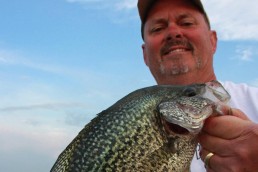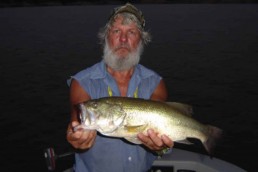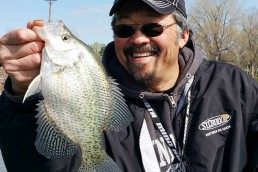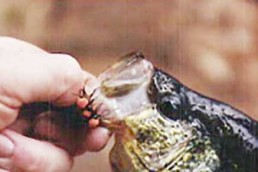Techniques for Catching Hot-weather Crappies
SHARE THIS POST
Summer offers variety, with crappies taking a back seat to most other species. However, the crappies don’t go away in hot weather and the right techniques and finding the spots can lead to good action. Clear lakes mean vegetation, with shallow areas likely to have topwater varieties, including lily pads and others. The vegetation can make presenting baits more difficult, but it’s not too hard to figure out how and where to present baits.
Why are the fish there? Shade.
Crappies do not have eyelids, so shade is critical for protection from the sunlight and they can use it to hide in so they can ambush their prey and receive protection from predators. Also, insects and minnows are plentiful in good vegetation, making it a great feeding place. And as a summer bonus, good oxygen levels are in active weeds.
There are ways to fish the floating and floating/submerged weeds. The best is to use vertical jigging. Weeds are frustrating when a hook gets hung, so jigging provides a straight up and down presentation for the fewest hang-ups. Equipment includes a long, sensitive 12-foot jigging pole, light line and a jig or minnow. A jig is preferred because it gets through the weeds best. The head can often be shaken free if it hangs slightly; the lead head offers good control of the bait.
The type jig can vary, and plastics are the most popular, but something different like a tinsel or feather jig can work great in cover. Since water will be relatively clear, look for soft colors including clear, smoke, light pink-white and soft yellow-white. Save the bold colors for stained or dingy waters.
Submerged vegetation tapers out into deeper water and can be another great place to find crappies. The actual depth might range to 10 feet or more, depending upon the water clarity and other factors. The key is to use your electronics to pinpoint the weeds and figure the best way to fish them. A great spot is a lake point extending out to a channel where weeds come out to a depth of 11 feet. As the bottom gets shallower, the weeds get taller. For example, in 8 feet of water, the weeds come up to 5 feet over the surface.
Casting is a fun, effective way to fish submerged weeds. After finding potential spots like a lake point or a cut within the weeds, make precision casts, making sure to keep the bait just above the weeds.
Are you enjoying this post?
You can be among the first to get the latest info on where to go, what to use and how to use it!
Casting a slip-flat rig with a minnow is another great choice. The minnow can be taken right to the edge of the cover where it will be in place for any crappies passing by. Early morning and late evenings are usually best when fish are on the fringe of the weeds and not too deep in them.
Going deep in stained water
Deep water can be a good choice, and sonar is needed to do a visual search on the underwater features looking for ledges, drops and wood cover. GPS is another important tool for marking potentially good spots to return to later. The more advanced the electronics are, the easier it can be.
The best part of any electronics is the time saved by not fishing “dead water.” You can see if water has structure, cover and fish before a hook is dropped. Getting the fish to bite is another thing, but knowing they are there provides the potential for success. Water with ample depth is not the only thing needed to find crappies. Also, look for structure like a hump or other irregular feature. Finding something “different” is a big advantage.
Another important factor is cover; stumps, submerged timber and man-made objects provide a home for fish. A crappie may leave for a while to suspend up or to travel to a nearby location, but the protection of cover is usually just a short swim away.
What’s deep? It could be 12 feet in a shallow lake, 40 feet in a clear lake, but in most, it’s around 15 to 25 feet. For our example, we’ll consider fish at 18 feet, with the water a few degrees cooler than the surface temperature. Light penetration is less, and the deeper water is better during any weather changes and when the boat traffic is beating the surface. If a thermocline develops, the fish will move up over this area no matter how deep the bottom depth may be. So, these fish could be at 18 feet over 35 feet of water.
Slow-trolling or holding a long pole in each hand is a good way to present baits deep, and to maintain control. The trolling motor is your guide to take baits where you want them to go. Your eyes will likely be glued to a locator screen part of the time and to the rod tips the rest. Or, if you are holding a pole in each hand, you can watch the screen and just feel the bites. This is a great tactic when crappies are deep.
Nocturnal wildcard
A fisherman either loves or hates night fishing, but it can be fantastic in summer. Night fishing gets away from most of the pleasure boaters and is more comfortable than fishing in the heat of the day. A point, ledge or other structure where fish are present during the day are the same spots that will be ideal at night. And crappies will move in to feed on shad schools that come to the lights.
MWO
SHARE THIS POST
Did you enjoy this post?
You can be among the first to get the latest info on where to go, what to use and how to use it!
Tim Huffman
Tim Huffman specializes in crappie fishing, is editor for two crappie magazines, as well as writing for several others. In 2018, he published his sixth book, Limiting Out for Crappie, available at Amazon. His first article appeared in MidWest Outdoors in 1988.



